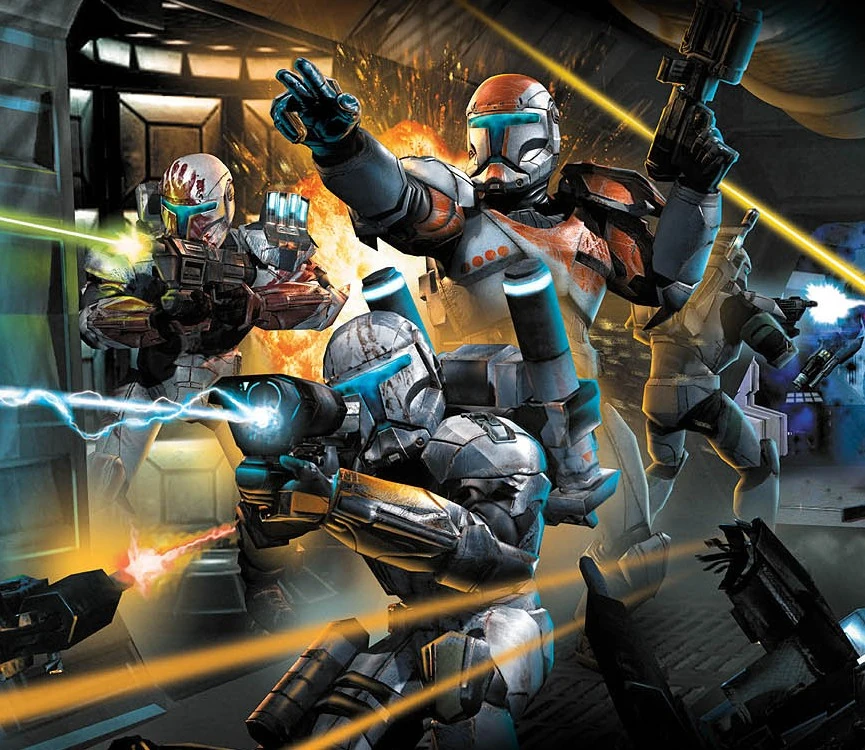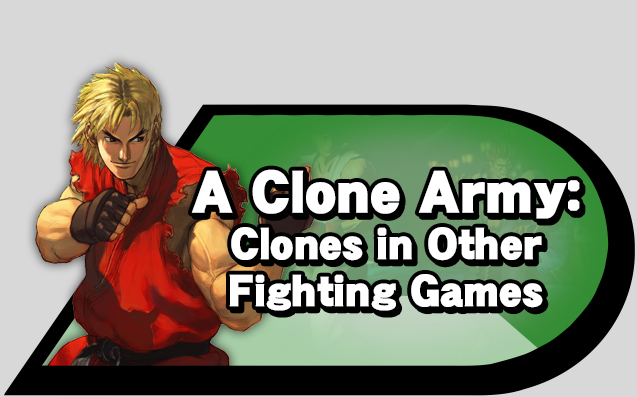Clones. The characters that made the Star Wars prequels either barely tolerable or insufferably boring.

But no one argues that this squad of clones is 100% awesome.
But in the context of fighting games, clones are a touchy subject. They either add a bit more meat to a roster or they drive people up walls due to their inclusion. Dark Pit surely did(and still does after two years for some reason), but the clones in Super Smash Bros. are not the only clones around. Pretty much every fighting game out there has them. So why not perhaps look at some of them and see just how much they differ from one another?
Let’s begin with the grandfathers of fighting game clones: Ken and Ryu from Street Fighter.

Shoryuken talk about us first.
These two are the quintessential examples of a character and their clone, having appeared in every game in the series to date. At first, they were carbon copies, having the exact same movesets and being merely head-swaps of one another (because the original Street Fighter had no scope for mirror matches, so they needed two identical characters for competitive play). During the Street Fighter II games, their stats, moves, and strategies began to differentiate, albeit little by little each new iteration (in the Super Turbo release, the duo had different basic attacks and special moves, whereas in The World Warrior, literally the only difference is Ken’s kick throw spins an extra time), but by the time the Alpha series started they had distinct backstories and extremely similar, but not identical, abilities.
Naturally, the series also includes Sakura, Akuma, and Dan, who borrow from Ryu’s moveset to an extent but also have their own unique qualities to make them stand out; Akuma’s style is not far from their own, Dan tends to at least share Ryu and Ken’s basic techniques albeit with different (read: pathetic and goofy) specials, while Sakura is possibly an aversion to the clone aspect due to her unusual permutations of Ryu’s special moves (and some different basic moves) that move her away from the model. Outside of Street Fighter, a character that has any combination of a fireball (or other projectile), a rising physical attack (usually an uppercut) and a spin attack is known as a shotoclone. Super Smash Bros. has a clear example of this in the form of Mario and Dr. Mario, and to an extent Luigi.
Next, a pair of clones that I’m quite familiar with: Cole and Evil Cole from PlayStation All-Stars Battle Royale.

Yes, you can just smell the differences.
The product of a certain point of view by the character’s owner Sucker Punch, the protagonist of inFamous was split into two characters for his appearance in PlayStation All-Stars. While you might think that this makes them pure moveset clones, the reality is that while they share some moves, the rest of their moveset couldn’t be less similar, making them completely different to fight and play as.
Both Coles are fighters that are most effective at mid-range with energy projectiles, solid movement options and easy ways to start combos, which is where the characters begin to diverge. Evil Cole’s moveset is more geared towards disruption and range fighting due to his projectiles being quick and easy to use repeatedly, with a few close range options as well that make combos almost guaranteed. Cole, on the other hand, is much more technical by comparison, as his projectiles are more of the stun variety, which makes them possible to chain together more than a few times for combos and kill confirms, rewarding precise timing to gain high amounts of AP for Super Moves. In regards to that, both characters share the same Level 1, grabbing an opponent with kinesis and launching them, but their Level 2 and 3 differ, having roughly the same effectiveness in comparison, with Evil Cole’s Level 3 being slightly superior to Cole’s.
The most obvious comparison to make with Smash is the Pit/Dark Pit duo. Unlike the angels, though, the Coles have plenty of gameplay differences to make them stand out from one another.
Finally, in the realm of major comparisons, let’s look at Tekken, which is unique in the aspect of clones in several ways. Starting off, the central protagonists of Tekken in the form of the Mishima family (mainly Heihachi, Kazuya and Jin) all share a common fighting style in the form of Mishima Style, which leads into them having similar movesets (and oddly enough, the characters Devil and Angel, whenever they appear, actually use Mishima Style karate mixed in with some unique moves despite having no bloodline relation to the Mishimas). Jin would adopt a more traditional karate style after Tekken 4, but in Tekken 5 Devil Jin is introduced, sporting the same moves pre-4 Jin had.

OW THE EDGE
But it doesn’t stop at the Mishimas. Tekken is a case where a lot of characters started off as clones of someone else, but underwent divergent character evolution in later games to make themselves different. These pairs include King and Armor King(who was revamped in Tekken 5: Dark Resurrection), Kuma and Panda, Jack and Prototype Jack, Baek and Hwoarang(bizarrely, the latter in 3 had oddly similar albeit not identical moves to the former from 2, but when they appeared together in 5, the amount of identical moves they had increased notably) and Roger and Alex(because for some reason a raptor can be made to fight just like a wrestling kangaroo). Time eventually separated these characters from one another gameplay-wise when they originally existed as palette swaps or filler clones, akin to Fox and Falco from Melee to Brawl or Mario and Luigi from Super Smash Bros. to Melee.
In the end, there are a massive amount of fighting games that incorporate clones, and if we listed them all we’d be here all day (though some are way too easy; just look at Marvel vs Capcom 2 and it’s myriad semi clones and palette swaps given slots). It’s easy to see why one side can decry clones as the absolute worst when they expect new blood in a roster, but if there’s a small space to be filled, then they can’t be all that bad, especially if there are newcomers aplenty already.









“and still does after two years for some reason”
Well he’s still in the game after two years.
When it comes to fighting games, clones are still a mixed subject, some will say “wasted potential”, others will say “this clone feels better than the original”, first impressions for clones can be negative, but as time passes, we grow to accept this specific character(s), sometimes you just can’t make people happy.
Smash, compared to other fighting games, is in a bit of a tricky spot when it comes to clones due to its status as a crossover. When a new character is announced, fans are already familiar with that character, and their minds jump to crazy new moveset potential based on their games. But when that character is revealed to be a simple copy-paste of another fighter’s moveset with some minor tweaking – such as when Dark Pit was leaked alongside the rest of Smash for 3DS’s cast – it becomes more of a letdown than it would be if the clone were a completely original character, like in other fighting games. Dark Pit could have had a legitimately interesting moveset, with his unlimited Power of Flight, staff, and potentially utilizing other weapons from Uprising such as claws – but instead, he was just a recolored Pit. One might argue that Pit and Dark Pit are so similar that they would obviously be clones, but while that is a valid point, pairs like Ness / Lucas and Link / Toon Link act as counterexamples.
Furthermore, whenever the final character roster for a Smash game is revealed, fans’ minds jump to the characters who did not make it in. There are some fans who jump to the faulty conclusion that clones take up “slots” from other, full-fledged characters – for example, the idea that Lucina’s inclusion led to King K. Rool being excluded from the roster. A more valid argument is clones replacing other clones. There is evidence [1] that Alph was at one point considered at one point to make the leap from alternate costume to full-blown clone, and potentially use Rock Pikmin to differentiate him from Olimar. Alph was scrapped as a clone, however, and in his place we got characters like Dark Pit. Not to pick on Pit’s doppelganger again, but many fans are disappointed in Dark Pit (as well as Dr. Mario and Lucina to some extent) because of the clones that he replaced. Sakurai and the team could have added an Olimar who used only Rock Pikmin, or even something like Dixie Kong, but instead we got a recolored version of Pit with only minor differences on a few moves and a Side Special that was more fit as a custom move than a reason to include an entirely new character.
The overarching theme here is the speculation and hype around Smash as a crossover franchise. Pulling characters from the biggest collection of gaming IP in the industry and beyond, Smash excites fans about what the next game could offer. Fans have connected with many of these characters outside of Smash, and everybody has that one character that they want to see in the game – or even just a character that they like from outside of Smash. But if that character is a clone, then the hype crashes and fans are let down. While other fighting games such as Street Fighter also have a lot of hype surrounding them, Smash is different in that it pulls together fan-favorite characters from all over gaming, meaning that fans have something to speculate over. Since fans do not know a character at all until they are introduced in Street Fighter itself, they do not have any expectations and thus are not as let down if that character ends up being a clone. Smash fans, on the other hand, spend a lot of time speculating about movesets, likeliness, etc regarding potential newcomers. Like in all aspects of Smash, in regards to clones the crossover aspect means that Smash can never fully please anyone, but that is a price worth paying in exchange for the hype and excitement that comes from gaming all-stars meeting in one title.
[1] https://sourcegaming.info/2015/07/29/plucky-little-guys-olimar-and-alph-in-smash-4/
Zatch Bell! Mamodo Battles has:
-Zofis/Milordo-Z
-Laila/Laila (Awakened)
Digimon Rumble Arena 2 has:
-Agumon/BlackAgumon
-Gabumon/BlackGabumon
-Guilmon/BlackGuilmon